Ways to a New Style in Architecture
GA 286
28 June 1914, Dornach
6. The New Conception of Architecture
During the time when the construction of our building is proceeding I think it is a very good thing for us to try to grow more and more into its meaning. We have already made a beginning with the two previous lectures and we will try as far as we can, by means of further study, really to become one with what is to be accomplished here.
In the first place I should like to remind you of what I said when we opened the house dedicated to the work of constructing the glass windows. The lecture referred to the evolution of thought and conception underlying the art of building and I will just briefly recapitulate what I was then only able to indicate.
In regard to the Greek Temple, I said that in a certain sense it formed a unity with the whole countryside—the whole countryside was one with it. The Temple stood there as the ‘dwelling place of the God.’ Nothing need be in the Greek Temple save the spiritual presence of the God and his physical image. The essence of the construction of the Temple was the fact that every man engaged in his daily pursuits on the land knew that within the region where he was carrying on his work he was not merely alone with the earth but united with the spiritual world. And the token for the fact that man, as he lived on the earth, was also united with the spiritual world, was the Temple standing there like an altar in the land.
We then saw evidence of progress in architectural thought, in that the Christian art of building separated off the edifice from the land. Everyday life and the mood of exaltation by which man raised himself to the Spirit were separated from each other. The Church of Christendom is no longer actually one with the land; it serves the Spirit, apart from the countryside, and expresses the fact that when man is to rise to the Spirit he must leave the affairs of daily life, repair for a time to a place set apart and there be united with the spirit. The Church of Christendom, therefore, could no longer be what the buildings of Greece and also of Rome were in their real being. The Church of Christendom was in itself a duality, the house of the community and the house set apart for the altar and the priesthood. Man leaves the affairs of everyday life and enters into the precincts where he feels himself gazing upwards to the Spirit which comes to him from the chancel where the altar stands.
This evolution in architectural thought naturally implies the transformation of the ancient Greek form of building (which was derived purely from static and dynamic factors, the factors of space and gravity) into the form corresponding to the conception of the community being set apart.
Passing to the Gothic Cathedral we have a still later form of architectural conception. We have the striving of the community not only to bear their own personalities into the sanctuary but also their individual work, and this is expressed in the forms of Gothic architecture. We feel as if the work performed in the environment has passed into the architectural forms and rises to the Spirit like a prayer, a folding of the hands.
I also said that a real advance in architectural conception must come to pass again in our times and that this is only possible if the nearness to the Spirit which was achieved to an ever-increasing extent from the period of the Greek conception of architecture onwards to that of Gothic building—if this nearness is gradually transformed into a complete union with the Spirit. This means that buildings which should now be dedicated to life in union with the Spirit must in their very form express inner correspondence with the Spiritual. We can indeed say—if we try not to explain the thing in abstractions but to grasp it with the whole of our feeling and soul—‘All that is embodied in our life of soul through Spiritual Science implies an actual penetration into the form that is created. The Spirit is revealed in freedom, having now descended to mankind.’ Whereas the Greek placed the Temple like an altar in the land, the future and, inasmuch as we are working from out of the future in our building, the present, are placing a true expression of the Spirit in the land as the result of what the Spirit expresses in its forms.
A speech which has a message for man of the present day will arise. But all this requires that we endeavour to understand the Spirit in its forms of expression. In order to understand the Greek Temple, we tried, last time, to grasp the purely physical qualities of space and of gravity. But the Spirit does not only work according to the laws of mechanics and dynamics; it does not only reveal itself in conditions of space and energy. The Spirit is living, hence it must be expressed in our building in a living way, a truly living way. We shall not understand this any better by interpreting the Spirit symbolically, but by beginning to feel that the forms are living, that they are organs of speech flowing from the spiritual world.
Is it possible for forms to speak from the spiritual world? It is indeed possible, in many ways. Let us take a thought that is specially near to us because on the one hand it is the expression of the highest, and on the other, in its Luciferic aspect it is submerged in the lowest—let us take the idea of the Ego, of Selfhood.
The mere utterance of the word “I” or “Self” does not as yet evoke much thought in man. Many epochs will have to run their course in human history before a fully conscious idea can arise in the soul when the word “I” or “Self” is uttered. Nevertheless, Selfhood, Ego-hood, can be felt in form, and above all when we pass from a purely mathematical conception of form to a feeling in form we can acquire a perception of Ego-hood, Selfhood, in the perfect circle. If you realise this you will readily understand what follows from it. If the true, living, sentient human being, confronting a circle, senses the feeling of Ego-hood, Selfhood, arising in his soul, or if when he sees a fragment of a circle he feels that it typifies the independent Self, he is learning to live in forms. And the characteristic of really living feeling is the capacity for living in forms. If you keep this in mind you will easily be able to pass on to other things that follow from it.
The first circle I have drawn here has an unbroken line (1).
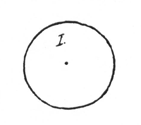
This line however can be varied so that it shows these wavy projections (2).
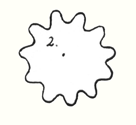 Another characteristic variation is the third figure (3).
Another characteristic variation is the third figure (3).
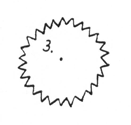 Both figures are only variations of the circle. What do these variations signify? The second (2) expresses the fact that the Self, the Ego has entered into relation with the outer world. The simple circle makes us feel that nothing of the rest of the world is there, only what is shut off within the circle. If we observe the circle in variation we can no longer feel that what is expressed by the circle is alone in the world. The variation in the line expresses a struggle, a kind of interplay with the outer world. If we really live into the form of the second variation (2) we shall feel: “The inner is stronger than the outer.” And in the case of the jagged circle (3): “The outer has bored its way in and is stronger than that which lies within the circle.” And now if we go into any building containing fragments of circles or rounded surfaces, and perceive variations of this kind, we shall feel in the case of the jagged lines, “here the outer has conquered,” and in the case of the wavy lines, “here the inner has conquered!” Our souls begin to live with the forms. We do not merely behold the forms but in our souls we have the living, pulsating feeling of “conquest and encroachment,” “victory and mastery.” The very soul lives with the form. And this union with form, this living in form is the very essence of true artistic feeling.
Both figures are only variations of the circle. What do these variations signify? The second (2) expresses the fact that the Self, the Ego has entered into relation with the outer world. The simple circle makes us feel that nothing of the rest of the world is there, only what is shut off within the circle. If we observe the circle in variation we can no longer feel that what is expressed by the circle is alone in the world. The variation in the line expresses a struggle, a kind of interplay with the outer world. If we really live into the form of the second variation (2) we shall feel: “The inner is stronger than the outer.” And in the case of the jagged circle (3): “The outer has bored its way in and is stronger than that which lies within the circle.” And now if we go into any building containing fragments of circles or rounded surfaces, and perceive variations of this kind, we shall feel in the case of the jagged lines, “here the outer has conquered,” and in the case of the wavy lines, “here the inner has conquered!” Our souls begin to live with the forms. We do not merely behold the forms but in our souls we have the living, pulsating feeling of “conquest and encroachment,” “victory and mastery.” The very soul lives with the form. And this union with form, this living in form is the very essence of true artistic feeling.
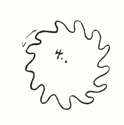
But we can go further. Let us picture to ourselves a less simple variation (4). The form moves in one direction and becomes action. If we live in this form we have the feeling that it advances, that it moves. In the forms themselves we find the quality of movement. I have here made a simple sketch of something that will appear in a complicated form in the building, but you will find that there is an absolute correspondence. Passing from the entrance at the West and thence towards the smaller structure (at the East) you will find that all the forms in the interior will evoke the feeling that the whole structure is proceeding from the West onwards to the East. This is expressed in the forms. At the West you will feel in thought that you are within a vehicle that is bearing you to the East. The very essence and meaning of these relief variations is that they do not merely appear as dead, dynamic or mechanical forms; we seem to enter a vehicle that bears us onwards. In a spiritual sense we shall not “rest” in our building; we shall be led onwards.
From this you will realise that the basic character of the forms here is quite different from the forms of the three stages of architectural thought which I have described. Up to our time architectural thought has been concerned with the qualities of lifeless, mechanical rest. Now, however architectural thought becomes the thought of speech, of inner movement, of that which draws us along with it. This is what is new in the whole conception, and the basic form must of course correspond to it. In what way does the basic form correspond to it? Now I have said that the most intimate of all impressions is that of the Self, the Ego, as expressed in the circle or sphere. Why is this? It is because the simple circle or sphere is of all forms the most easily perceptible. It is an absolutely simple matter to recognise a circle. All that is necessary is the most trivial thought that everything is equidistant from the central point. As soon as we picture to ourselves points standing at an equal distance from this centre, we have the sphere, or circle. It is the very easiest process that can be carried out in thought. As form, then, the circle is the simplest of all entities. This is also in accordance with external reality, for the Selfhood in every being, from the simplest cell to the complex human being, is the simplest of all impressions, just like the circle or sphere. Behind all this there is something much deeper and I want you now to follow me in a thought that will lead those who really understand it, to great profundities.
Now the form of an ellipse is more complex than that of the circle. I will draw the form of an ordinary ellipse. It need not be exact but merely have the general character of an ellipse. The simplicity of the thought is no longer there when we pass to the ellipse. Although the ellipse is still spherical, we have no longer the nature of equality as in the case of the circle. Here I must ask those who have studied geometry—although for politeness sake we will assume that you all know a little of geometry though you may have forgotten some of it—to try to understand the following ideas. There is also order and regularity in the ellipse. Just as the circle is related to one point, the ellipse is related to two. 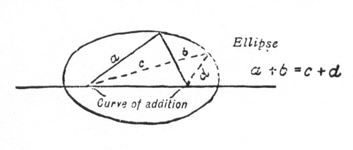 The lines between any point of the ellipse and the two foci will naturally differ, but the two lines together will come to the same length (a + b = c + d in diagram). You can add the distances of each point from these two foci and you will always get the same length. This is so simple in the case of the circle that there is no need for an mental process. In the case of the ellipse, however, we must make an addition. All lines to the centre of the circle are equal, but in the ellipse we have to make an addition. Now you will say: ‘Yes, but I do not add when I see an ellipse.’ You yourself do not, it is true, but your astral body does; what the geometrician does consciously the astral body does unconsciously. The astral body is a finished geometrician. You have no idea of all the knowledge that is contained in your astral bodies; in the astral body you are all the wisest of geometricians, only of course the geometry you know in the astral body can only be brought into consciousness by the ‘sweat of the brow.’ You must pardon this expression but it is permissible to-day (... it was very hot on the day this lecture was given.) Everything is there in the astral body and if those who teach geometry, instead of using their wonted methods, could apply a pump in order to extract what is in the astral body, they would no longer need to teach—the knowledge would well up of itself. We add, then, the two distances from the foci and always get the same result. When an ellipse form seems beautiful, what does this really imply? It implies that the astral body is adding and the sum total is always the same. And now picture to yourselves that you are adding without knowing it and every time getting the same result. You feel pleased. Now you go to another point and carry out the same process. ... The same total again—oh! what joy! This is the living experience of the ellipse.
The lines between any point of the ellipse and the two foci will naturally differ, but the two lines together will come to the same length (a + b = c + d in diagram). You can add the distances of each point from these two foci and you will always get the same length. This is so simple in the case of the circle that there is no need for an mental process. In the case of the ellipse, however, we must make an addition. All lines to the centre of the circle are equal, but in the ellipse we have to make an addition. Now you will say: ‘Yes, but I do not add when I see an ellipse.’ You yourself do not, it is true, but your astral body does; what the geometrician does consciously the astral body does unconsciously. The astral body is a finished geometrician. You have no idea of all the knowledge that is contained in your astral bodies; in the astral body you are all the wisest of geometricians, only of course the geometry you know in the astral body can only be brought into consciousness by the ‘sweat of the brow.’ You must pardon this expression but it is permissible to-day (... it was very hot on the day this lecture was given.) Everything is there in the astral body and if those who teach geometry, instead of using their wonted methods, could apply a pump in order to extract what is in the astral body, they would no longer need to teach—the knowledge would well up of itself. We add, then, the two distances from the foci and always get the same result. When an ellipse form seems beautiful, what does this really imply? It implies that the astral body is adding and the sum total is always the same. And now picture to yourselves that you are adding without knowing it and every time getting the same result. You feel pleased. Now you go to another point and carry out the same process. ... The same total again—oh! what joy! This is the living experience of the ellipse.
In the case of the circle there is no such feeling of satisfaction, for the circle is so immediately obvious. The ellipse causes us greater joy because there we have to be inwardly active. The more one is inwardly active, the greater joy one has. What is often so difficult to realise is that man, in his inner being, craves for activity. If he wants to be lazy this is merely an affair of his conscious life. The astral body is not only wiser, but also more industrious and would like always to be active.
Now there is another line consisting, of course, always of two portions. Those who have studied geometry will know that the hyperbola consists of two symmetrical curves. 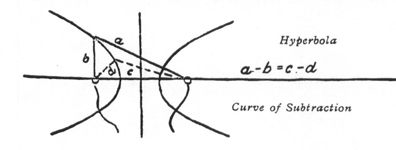 The hyperbola also has two foci which lie approximately here. Again we can draw lines to these two points. The strange thing here is that we do not add but subtract. We always get the same result by subtracting the lesser from the greater. Our astral body subtracts and is glad that the difference is always the same. In this inner feeling of equality the astral body experiences the source of the hyperbola.
The hyperbola also has two foci which lie approximately here. Again we can draw lines to these two points. The strange thing here is that we do not add but subtract. We always get the same result by subtracting the lesser from the greater. Our astral body subtracts and is glad that the difference is always the same. In this inner feeling of equality the astral body experiences the source of the hyperbola.
Man is thus a mathematician in the substrata of his consciousness and by means of subconscious calculation we create for ourselves regularity of form. We add and subtract, but we can also multiply. Here again we have two points. Multiplying the one by the other we again get a line that looks somewhat like the ellipse but is not the same. This line contains an inner process of multiplication.

This line has something mysterious about it. The circle is a simple entity, the ellipse already more complicated, the hyperbola still more so, for I do not think that the ordinary person sees only one single line in the two curves. The ordinary intellect believes there are two curves. The ordinary intellect believes there are two lines, but in reality this is not so. The other line is mysterious for another reason, for according to what is produced by multiplication the line is changed into this curious form. It is the curve of multiplication, the curve of Cassini, the lemniscate which plays so important a rôle in occult investigations. The line can develop in such a way that it assumes these forms. There are two lines, you see, but in the inner sense there is really one line, and when we feel it as one line in the astral world we know that this form (o-o) is only a specialisation of this form ( ∞ ). But now think—this form ( ∞ ) disappears into the fourth dimension—then appears again and enters the physical world. It is an unity because it ever and again disappears into the fourth dimension. This multiplication process has really three different forms.
We have therefore a line of addition, a line of subtraction, a line of multiplication. Someone may say that there must then be a line of division, the fourth method of calculation. 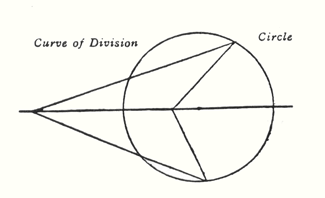 There we must divide two distances instead of adding, subtracting or multiplying. That is to say, it must be possible for our astral body to determine two points—and also other points if it takes the larger line—and to divide the greater distance by the smaller. The astral body, then, must be able to divide and when it does this it gets a line (see diagram). All the points are so that their distances from two points are the same in the division.
There we must divide two distances instead of adding, subtracting or multiplying. That is to say, it must be possible for our astral body to determine two points—and also other points if it takes the larger line—and to divide the greater distance by the smaller. The astral body, then, must be able to divide and when it does this it gets a line (see diagram). All the points are so that their distances from two points are the same in the division.
We add and get the ellipse.
We subtract and get the hyperbola.
We multiply and get the curves of Cassini, the Lemniscate.
We divide and get the circle.
Now we have something very remarkable indeed. When we really try to penetrate into the depths of nature they appear before the soul in all their wonder. The circle appears to be an utterly simple entity but it is, nevertheless, full of mystery. The circle can also be understood by taking two points and dividing, and inasmuch as the same result is arrived at, we get the circle. The circle is thus something very remarkable. It is the simplest of all entities and yet it is the product of an occult process of division that is brought into consciousness. It is just the same in the case of the self of man: the ordinary self is the simple entity and the higher self the mysterious entity resting in the depths of being—a self that can only be found when we transcend its limits and pay heed to the world with which it is connected. The circle is the same whether we say that it is the simplest of all forms or that the product of division from two points is always the same. Just as we have the same circle, so we have within ourselves a duality: something that belongs to everyday life and is readily perceptible, and something that we only grasp when we go out to the whole universe, conceiving of this entity as the most complicated product of the great cosmic struggle where Ahriman and Lucifer carry out the division and where our own higher self has to maintain itself as the quotient if it is ever to come to expression.
Portions of the ellipse and of the hyperbola and also of the curves of Cassini will be found everywhere in our building, and your astral bodies will have plenty of opportunity to make these calculations! Here I will only mention one instance: when people go into our building and stand in the gallery where the organ and the singers will stand, their souls will be able to carry out this process of multiplication. The soul may not do so consciously but it will feel this process in the depths of its being, because this is the line of the structure around the organ. This line will be found in many places in the building.
After what I have now told you about the twofold meaning of the circle you will be able to realise that when you enter the building from the West and feel yourselves surrounded by the circular structure, by the cupola above, that here is the image of the human self. But the other smaller space in the East is not at first sight so intelligible. The smaller structure will seem to be full of mystery because, although its form is also circular, it must be conceived of as the result of a process of division and it only outwardly resembles the larger space. There are two circles, but the one corresponds to the life of everyday and the other is connected with the whole cosmos. We bear within us a lower self and a higher self. Both again are one. Thus our building had to be a twofold structure. Its form expresses—not in any symbolical sense but in its very being—the dual nature of man. When the curtain in front of the stage is open we shall perceive an image of man not only as he is in everyday life, but as complete man. The forms themselves express a movement from West to East, the path of the lower to the higher Self. All that I have told you can actually be felt in the forms. The erection of a building of this kind reveals how the spiritual form of nature and the higher spiritual world can be expressed. Nobody who begins to think out all kinds of ingenious interpretations will Understand our building. It can only be understood by a living feeling of the development and being of the forms. For this reason I do not want to describe the building pictorially but to speak of the mode of its development, how spiritual being itself has become form and movement and has flowed into it. Suppose anyone were to look at the interior and begin to speculate thus: ‘Yes, two cupolas, two circular structures—lower Self, higher Self; a lower Self, a higher Self—a unity.’ This may be a neat interpretation but it would be of no more value than if it were said that Maria and Johannes Thomasius in the Mystery Plays are really one being. This is a mere speculation, for it results in an abstraction. The unity lies in the living ‘becoming.’ Naturally the living powers of becoming can bring forth both Maria and Thomasius but only as the result of a differentiation. Even in similarity the true occultist will always seek for diversity, for it would be false occultism to desire always to lead back diversity to unity. Hence the example of the circle. The circle is the simplest of all entities, where all points are equidistant from the centre—but it is also the result of division. In the circle we have something that is a unity in the outer world and complex in the spiritual world.
These are some of the remarks I desired to make. On another occasion I shall speak further on these matters. I shall now speak briefly of other things.
Man, as he enters the world, is really a highly complicated being. When he enters the world—as I have often said—he cannot at first stand upright; lie crawls, and at the very beginning of his existence he does not even crawl. Gradually he learns to control the forces which make him able to stand upright. 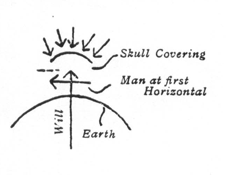 Let me try to make a diagrammatic sketch of this process. Underneath we have the Earth. Man is at first a horizontal being; then he stands upright—in the vertical position. It is an achievement of man's nature itself to attain the vertical position but he has the help of all the hierarchies as he passes through the course of his life. What is it that comes to his aid when he stands upright and walks? The forces that work from the Earth out into the expanses of cosmic space. These are the earthly forces. To-day physicists only speak of purely physical forces of the Earth—forces of attraction, of gravity and the like. The Earth, however, is not merely physical body but a being of spirit and soul and when, as little children, we raise ourselves to the upright position and walk, we are uniting ourselves with the forces of Will rising out of the Earth. The Earth-Will permeates our being; we allow the Earth -Will to flow into us and place ourselves in the upright position—the direction of the Earth-Will. This process is a union with the Earth-Will. But in opposition to the Earth-Will there is a will that works in from all sides of the cosmos. We have no knowledge of it, but yet it is the case that as we raise ourselves to the upright position, forces (from the cosmos) are working in from all sides and we come up against these forces that are pouring in from outside. This has no particular significance to-day, on the Earth, but during the ancient Moon period it had a tremendous significance. On the ancient Moon, conditions were such that from his earliest childhood man had a different orientation, in that he had to place himself in line with the direction of the Moon-Will. As the result of this he acquired the first germs of the skull formation. To-day we have inherited them, but on the Moon it was a question of acquiring them. In those times man worked in himself against the outer will-forces somewhat in the way a locomotive works when it has to push away snow. He pressed back the will-forces of the cosmos and his soft skull formation compressed itself into the hard skull covering. To-day this process is no longer necessary. The skull formation is inherited. It is no longer necessary to build up the skull bones. In the etheric body, however, we still build them, for as we rise to the upright position there is a densification in the head, representing the result of the fight between the forces streaming in from all sides of the cosmos. Thus, when we observe the etheric body, we may say that in his two legs, man builds up two lines of force and works against the forces that proceed from without. The etheric body is densified and this form arises (see next diagram). We raise ourselves upright. The physical legs have their junction above, but the etheric legs rise still higher.
Let me try to make a diagrammatic sketch of this process. Underneath we have the Earth. Man is at first a horizontal being; then he stands upright—in the vertical position. It is an achievement of man's nature itself to attain the vertical position but he has the help of all the hierarchies as he passes through the course of his life. What is it that comes to his aid when he stands upright and walks? The forces that work from the Earth out into the expanses of cosmic space. These are the earthly forces. To-day physicists only speak of purely physical forces of the Earth—forces of attraction, of gravity and the like. The Earth, however, is not merely physical body but a being of spirit and soul and when, as little children, we raise ourselves to the upright position and walk, we are uniting ourselves with the forces of Will rising out of the Earth. The Earth-Will permeates our being; we allow the Earth -Will to flow into us and place ourselves in the upright position—the direction of the Earth-Will. This process is a union with the Earth-Will. But in opposition to the Earth-Will there is a will that works in from all sides of the cosmos. We have no knowledge of it, but yet it is the case that as we raise ourselves to the upright position, forces (from the cosmos) are working in from all sides and we come up against these forces that are pouring in from outside. This has no particular significance to-day, on the Earth, but during the ancient Moon period it had a tremendous significance. On the ancient Moon, conditions were such that from his earliest childhood man had a different orientation, in that he had to place himself in line with the direction of the Moon-Will. As the result of this he acquired the first germs of the skull formation. To-day we have inherited them, but on the Moon it was a question of acquiring them. In those times man worked in himself against the outer will-forces somewhat in the way a locomotive works when it has to push away snow. He pressed back the will-forces of the cosmos and his soft skull formation compressed itself into the hard skull covering. To-day this process is no longer necessary. The skull formation is inherited. It is no longer necessary to build up the skull bones. In the etheric body, however, we still build them, for as we rise to the upright position there is a densification in the head, representing the result of the fight between the forces streaming in from all sides of the cosmos. Thus, when we observe the etheric body, we may say that in his two legs, man builds up two lines of force and works against the forces that proceed from without. The etheric body is densified and this form arises (see next diagram). We raise ourselves upright. The physical legs have their junction above, but the etheric legs rise still higher. 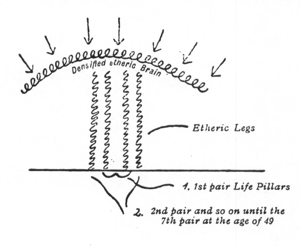 As a result of this the etheric head is densified and as a result of the formation of the brain there arises in the etheric body, in our age as well, the densified etheric body. This does not only take place in childhood but as man passes through seven life periods (from the first to the seventh year, from the seventh to the fourteenth year and so on) new lines are formed, lines of different forces which pass upwards. So that when we have reached the age of full and complete manhood—when we have passed the fiftieth year of life—we have added new pairs of pillars to that first strong pair formed during the first seven years of life. They appear in the etheric body in different colours. We strengthen our etheric sheath every time we develop these ‘life pillars’—for so indeed they may be called. After the first period of seven years the first pair of life pillars is completed, at the fourteenth year the second pair, at the twenty-first year the third pair, and finally, with the forty-ninth year, the seventh pair. Each pair of life pillars makes our etheric skull-covering more secure. Man passes through his life and after every seven years raises within himself different pillar formations which bear his skull. When we have understood this we shall have a living conception of the inner form of the larger section of our building. We enter at the West and say to ourselves: ‘Up to the first pair of pillars we see how man develops in the first seven years of his life; the second pair of pillars denotes his development to his fourteenth year, then on to the twenty-first year and so on.’ And the etheric sheath of the head is always around us. Man, the living being, is poured out into the forms as an etheric being.
As a result of this the etheric head is densified and as a result of the formation of the brain there arises in the etheric body, in our age as well, the densified etheric body. This does not only take place in childhood but as man passes through seven life periods (from the first to the seventh year, from the seventh to the fourteenth year and so on) new lines are formed, lines of different forces which pass upwards. So that when we have reached the age of full and complete manhood—when we have passed the fiftieth year of life—we have added new pairs of pillars to that first strong pair formed during the first seven years of life. They appear in the etheric body in different colours. We strengthen our etheric sheath every time we develop these ‘life pillars’—for so indeed they may be called. After the first period of seven years the first pair of life pillars is completed, at the fourteenth year the second pair, at the twenty-first year the third pair, and finally, with the forty-ninth year, the seventh pair. Each pair of life pillars makes our etheric skull-covering more secure. Man passes through his life and after every seven years raises within himself different pillar formations which bear his skull. When we have understood this we shall have a living conception of the inner form of the larger section of our building. We enter at the West and say to ourselves: ‘Up to the first pair of pillars we see how man develops in the first seven years of his life; the second pair of pillars denotes his development to his fourteenth year, then on to the twenty-first year and so on.’ And the etheric sheath of the head is always around us. Man, the living being, is poured out into the forms as an etheric being.
The advance from Gothic architecture to that of Spiritual Science may be described as follows: Gothic architecture contains the prayer: ‘O Father of the Universe, may we be united with Thee, in Thy Spirit.’ Those who know what this prayer contains, who really understand the living development of Spiritual Science, will solve the riddle of the evolution of man. And then, when the forms of architectural thought strive to be united with the Spirit—expressing this striving in their very being—man will feel how he has been permeated with the hidden Spirit and can have around him a building which is a direct expression of the living, inner development of his being.
‘We dwell in the land, but the Spirit is among us.’ This is the Greek thought of architecture.
‘We dwell for a season in the sanctuary and the Spirit comes to us.’ This is the thought behind Christian architecture.
‘We dwell for a season in the sanctuary, but we uplift the soul by raising ourselves to the Spirit.’ This is the thought behind Gothic architecture.
‘We enter with reverence into the Spirit in order that we may become one with the Spirit poured out around us in the forms—the Spirit that moves and is active, because behind the Spirits of Form stand the Spirits of Movement.’ This is the thought behind the new architecture.
Existence thus advances through earthly evolution and it is man's task to understand the inner meaning and purport of this existence. He only advances in the wake of true evolution when he endeavours, in every epoch, to experience what the spiritual world bestows in that epoch.
Why do our souls pass through different, successive incarnations? Not in order that we may repeat the same experiences, nor that we may pass through re-birth, re-naissance, again and again, but in order that we may assimilate, ever and again, the new that pours into our souls from out the spiritual worlds. We are standing at a definite point in the evolution of humanity in the sphere of art and in many other spheres of spiritual life—at a point where the Spirit speaks clearly to us of new riddles. And just as in the time of the Renaissance man was destined primarily to orientate himself to the past in order to work his way through to the new, so it is with our own external knowledge and perception of the universe. All that has been produced by the modern age since the sixteenth century is only the preparation for a living experience of the universe in its forms and movements which now stand before us as riddles.
This, then, is all for to-day. In another lecture I will try to approach questions of a still more intimate character—questions relating to the living soul of nature in connection with colour and the art of painting.
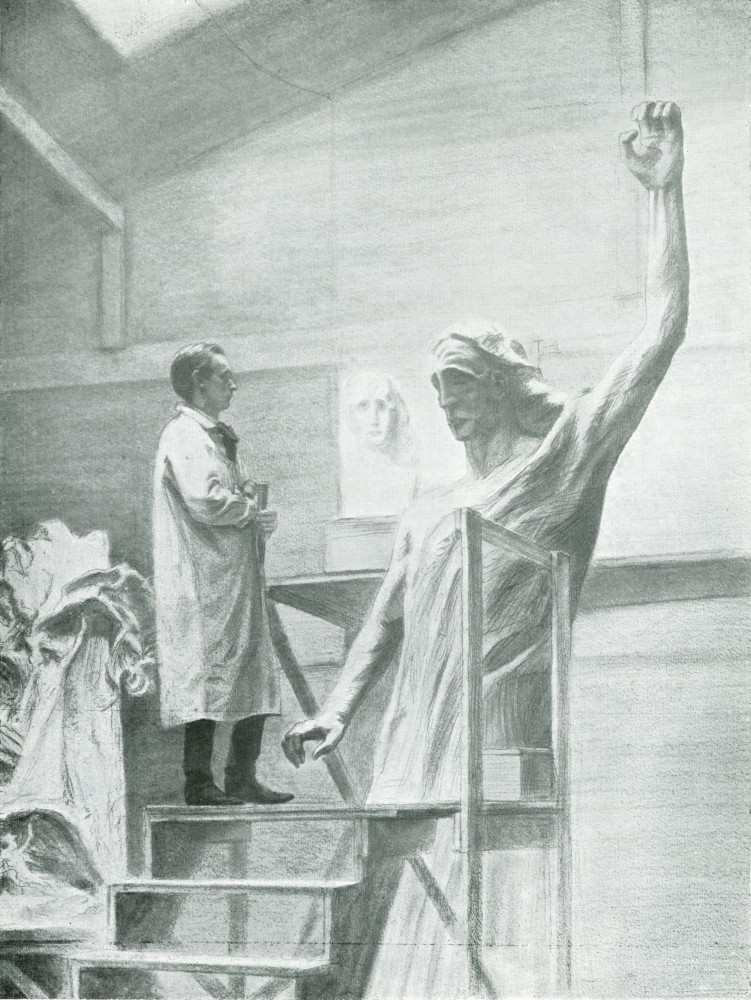
to the left the model made by him; in the middle, Christ, the Representative of humanity;
above, Lucifer fallen; below, Ahriman imprisoned.
From a drawing by W. S. Pyle.
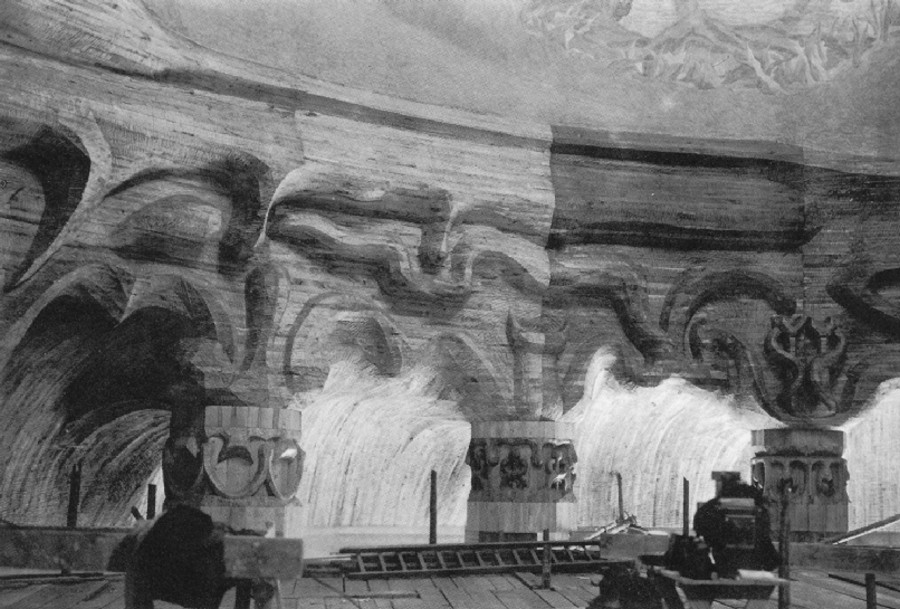
Architraves and Capitals of Pillars during the Building Work.
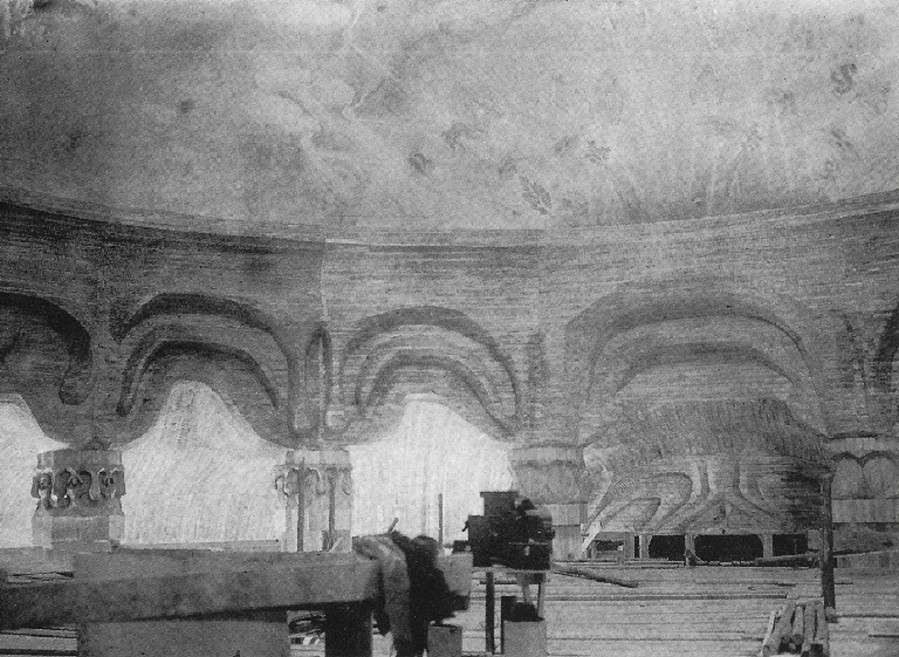
Architraves and Capitals of Pillars during Building.
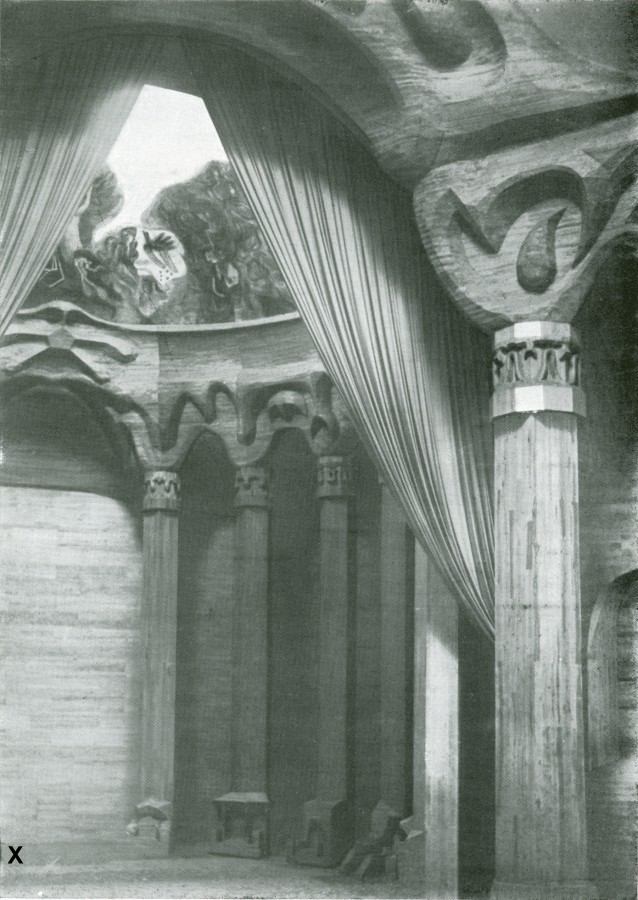
In the background the small Cupola with Stage
(X) Here the great wooden sculptured group of the Representitive of Humanity was to have stood.
6. Der Neue Baukünstlerische Gedanke
Meine lieben Freunde! Ich denke, es ist recht gut, wenn wir im Fortgange unseres Baues versuchen, immer weiter und weiter in seinen Sinn hineinzuwachsen. Wir haben ja damit begonnen durch die beiden Betrachtungen, die wir schon angestellt haben, und werden, so gut es geht, in den nächsten Zeiten durch weitere solche Betrachtungen versuchen, gewissermaßen eben eins zu werden mit dem, was hier entstehen soll.
Zunächst möchte ich Sie erinnern an eine Bemerkung, die ich gemacht habe gelegentlich der Eröffnung des Hauses, das gewidmet sein soll der Ausarbeitung der Fenster zu unserem Bau. Diese Bemerkung hat sich ja bezogen auf die Entwickelung, ich möchte sagen, des baukünstlerischen Gedankens, der baukünstlerischen Vorstellungen. Ich will nur ganz kurz rekapitulieren dasjenige, was ich dazu auch nur andeutungsweise habe bemerken können.
Von dem griechischen Tempel ist gesagt worden, daß er gewissermaßen eins bildet mit der ganzen Landschaft, sich hineinstellt in die ganze Landschaft, und daß die Landschaft eigentlich mit ihm zusammengewachsen ist, so daß der Tempel «das Wohnhaus des Gottes» ist, daß in diesem Tempel nichts zu sein braucht als geistig der Gott anwesend und physisch sein Bildnis, und daß das Wesentliche in der Formgebung des Tempels darauf beruht, daß gleichsam jeder Mensch bei seiner alltäglichen Beschäftigung in der Landschaft weiß: innerhalb des Gebietes, in dem ich diese oder jene Arbeit verrichte, bin ich nicht mit der Erde bloß allein, sondern ich bin zusammen mit der geistigen Welt. Und das Wahrzeichen dafür, daß man, indem man einfach die Erde bewohnt, zusammen ist mit der geistigen Welt, das ist die Tatsache, daß in der Landschaft drinnen der Tempel gleichsam wie ein Altar steht.
Wir haben dann gesehen, wie ein gewisser Fortschritt im baukünstlerischen Gedanken darin liegt, daß die christliche Baukunst das Gebäude absonderte von der Landschaft, daß gewissermaßen die Alltäglichkeit und die gehobene Stimmung, durch die man sich zum Geiste erhebt, zwei werden, so daß der christliche Bau nicht mehr eigentlich eins ist mit der Landschaft, sondern weil er dem Geiste abgesondert von der Landschaft dient, nun gleichsam ausdrückt: Wenn der Mensch sich zum Geiste erheben soll, dann muß er hinausgehen aus der Alltäglichkeit, er muß sich in abgesonderter Stätte aufhalten und da mit dem Geiste vereinigt sein. - Dadurch konnte der christliche Bau nicht mehr das sein, was der griechische und auch noch der römische Bau war, sondern er wurde in sich selbst eine Zweiheit: das Haus der Gemeinde und das abgesonderte Haus für den Altar und die Priesterschaft. Der Mensch ist herausgetreten aus der Alltäglichkeit und auf den Boden getreten, auf dem er sich fühlt hinaufschauend zum Geiste, und entgegen kommt ihm der Geist durch das Gehäuse des Altars.
Mit dieser Fortentwickelung des baukünstlerischen Gedankens ist selbstverständlich gegeben die Umformung der alten griechischen Bauform, die rein aus statischen und dynamischen Verhältnissen, aus Verhältnissen des Raumes und der Schwerkraft herausgewachsen ist, wie ich es angedeutet habe, in diejenige Form, die sich gewissermaßen dem Absonderungsgedanken der Gemeinde anpaßt.
Und rücken wir dann vor zum gotischen Dom, so haben wir gleichsam eine weitere Form des baukünstlerischen Gedankens. Wir haben das Streben der Gemeinde, nicht nur die eigene Persönlichkeit des Einzelnen hineinzutragen in das Tempelhaus, sondern auch die Arbeit des Einzelnen hineinzutragen; und das drückt sich aus in den Formen der gotischen Baukunst. Man fühlt gleichsam, wie das, was in der Umgebung gearbeitet worden ist, in den baukünstlerischen Formen zusammengetragen worden ist und sich wie eine Bitte, wie eine Händefaltung erhebt zu dem Geistigen.
Ich habe dann gesagt, wie nun ein wirklicher Fortschritt im baukünstlerischen Gedanken in unserer Zeit sich wieder vollziehen muß, und wie er sich nur dadurch vollziehen kann, daß gewissermaßen die Annäherung zum Geistigen, die sich immer mehr vollzogen hat von dem griechischen bis zum gotischen baukünstlerischen Gedanken, sich allmählich verwandelt in ein Einswerden mit dem Geiste. Das heißt, das Haus, das dem Zusammenleben mit dem Geiste nunmehr gewidmet sein muß, muß eine innige Gemeinschaft der Form mit dem Geistigen selbst darstellen. Man könnte dann sagen, wenn man nicht versucht ist, die Sache bloß abstrakt zu meinen, sondern sie mit dem ganzen Gefühl, mit der ganzen Seele umfassen kann: Alles das, was mit der Geisteswissenschaft sich in unser Seelisches einlebt, das ist wieder das Leben in der Form, die wir errichten. Frei erscheint der Geist, wie heruntergestiegen nun zum Menschen.
Während der Grieche wie einen Altar den Tempel in die Landschaft gestellt hat, stellt die Zukunft und - insofern wir arbeiten aus dieser Zukunft heraus mit unserem Bau - die Gegenwart den Geist selbst in seiner Ausdrucksform hinein in das Landschaftsgebiet. Und es muß dann selbstverständlich durch das, was der Geist in seinen Formen zum Ausdruck bringt, gegeben sein etwas, was wie eine Sprache zu den Menschen der Gegenwart spricht, wie ich das verschiedene Male angedeutet habe. Zu alledem aber ist notwendig, meine lieben Freunde, daß wir versuchen, den Geist zu verstehen in seiner Formengebung. Wir haben, um den griechischen Tempel zu begreifen, das letzte Mal versucht, ich möchte sagen, das rein Physikalische des Raumes und der Schwerkraft uns klarzumachen. Aber der Geist ist nicht bloß ein Mechaniker und Dynamiker, er zeigt sich nicht nur in Raum- und Kraftverhältnissen, der Geist ist lebendig, und die Folge davon ist, daß sein Ausdruck im Bau ein lebendiger, ein richtig lebendiger ist. Das, was ich damit gesagt habe, werden wir nicht dadurch besser verstehen, daß wir nun etwa anfangen, den Geist in symbolischer Weise zu deuten, sondern dadurch, daß wir anfangen, die Formen wirklich als lebendige zu fühlen, daß wir die Formen empfinden als Organe eines Sprechens aus der geistigen Welt.
Können Formen sprechen aus der geistigen Welt? Formen können vielerlei sprechen aus der geistigen Welt heraus. Nehmen wir einen Gedanken, der uns gerade besonders naheliegt, weil er auf der einen Seite der Ausdruck des Höchsten ist und auf der anderen Seite in seiner luziferischen Prägung in das Niedrigste eintaucht: den Gedanken des Ich, den Gedanken der Selbstheit.
Es ist ja nicht zu leugnen, daß beim bloßen Ausdruck des Wortes «Ich», «unser Selbst», der Mensch eigentlich noch nicht besonders viel denken kann. Es werden noch mancherlei Zeitepochen hinunterfließen müssen in der Menschheitsgeschichte, bis eine vollbewußte Vorstellung in der Seele auflebt, wenn das Wort «Ich» oder das Wort «Selbst» ausgesprochen wird. Aber in der Form kann die Selbstheit, die Ichheit empfunden werden, und zwar, wenn man vom rein mathematischen Formwissen zum Formfühlen übergeht, dann wird man stets empfinden bei dem völligen Kreis die Ichheit, die Selbstheit. Kreis fühlen würde heißen Selbstheit fühlen. Kreis fühlen in der Ebene, Kugel fühlen im Raum, ist Selbstheit fühlen, Ich fühlen. Wenn Sie sich das klarmachen, werden Sie auch das weitere leicht verstehen. Wenn Sie sich klarmachen, daß im Grunde genommen der wirklich lebendig empfindende Mensch, wenn er einem Kreise gegenübersteht, in seiner Seele auftauchen fühlt das Gefühl der Ichheit, das Gefühl der Selbstheit, so daß, indem er das Kreisrund sieht, oder nur ein Stück von dem Kreis sieht, oder wenn er ein kleines Stück Kugelschale sieht, er fühlt, daß das hindeutet auf das «Sich-selbständig-Fühlen». Wenn der Mensch so fühlt, dann lernt er in Formen leben. Und es ist gewissermaßen das Charakteristische des lebendigen Fühlens, in den Formen leben zu können. Nun werden Sie, wenn Sie dieses in Betracht ziehen, zu dem weiteren leicht übergehen können.
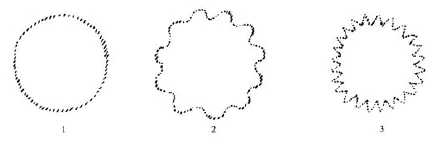
So wie ich die Kreislinie hier gezeichnet habe, ist sie zunächst ganz ungegliedert [1]. Sie kann aber in zweifacher Weise gegliedert sein, so daß sie aussendet solche Vorsprünge [2]. Das wäre eine Gliederung. Eine andere charakteristische Gliederung wäre diese [3]. Beide Formen sind eigentlich nur gegliederte Kreise. - Was bedeuten diese Gliederungen? Diese Gliederung [2] bedeutet, daß das Selbst, das Ich, in Beziehung getreten ist zur Außenwelt. Wenn wir dem bloßen Kreis gegenüberstehen, dann können wir das Gefühl haben, daß die ganze übrige Welt nicht da sei, daß nur das sich im Kreise Abschließende da sei. Wenn wir den gegliederten Kreis betrachten, dann können wir nicht mehr das Gefühl haben, daß das, was durch den Kreis ausgedrückt ist, allein in der Welt ist. Die Gliederung der Kreislinie drückt aus einen Kampf, gewissermaßen eine Wechselbeziehung mit der Außenwelt. Und es ist charakteristisch, daß derjenige, der nun sich lebendig hineinfühlt in die Form bei dem gegliederten Kreis [2], fühlt: das Innere ist stärker als das Äußere! Und beim zackig ausgebildeten Kreis [3]: das Äußere hat sich eingebohrt und ist stärker als das, was im Kreise liegt. Und geht man nun durch irgendeinen Raum, der irgendwie Stücke von Kreislinien oder Kugelflächen hat, und merkt man daran solche Gliederungen, so kann man, indem man einfach die Linien verfolgt, von der Zackenlinie das Gefühl haben: Ah, hier siegt das Äußere! Und bei der Wellenlinie: Ah, hier siegt das Innere! Und es beginnt unsere Seele mitzuerleben mit der Form. Wir schauen sie nicht bloß an, sondern wir haben das lebendige, auf- und abwogende Gefühl «Überwindung und Übergriff», «Überwindung und Besiegung in der Seele, das heißt, unsere Seele gerät in Lebendigkeit, sie lebt mit der Form mit. Und das ist das Wesen des künstlerischen Empfindens, dieses Einswerden mit der Form, dieses Mitleben mit der Form.
Aber wir können weitergehen. Denken Sie sich die Gliederung nicht so einfach, wie sie hier ist, sondern so [4]:
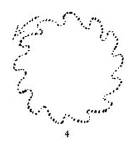
Das heißt, die Form bewegt sich nach der einen Richtung hin und sie ist Tat. Meine lieben Freunde, wer einigermaßen sich hineinlebt in diese Form, der hat unmittelbar das Gefühl: sie geht weiter, sie bewegt sich. So finden wir in den Formen selbst das Charakteristikum der Bewegung.
Ich habe in der einfachen Weise Ihnen hier etwas aufgezeichnet, was Sie in dem Bau kompliziert finden werden, aber Sie finden doch eine ganz bestimmte Einheit. Nämlich, wenn Sie sich den Westeingang denken, und Sie würden nach dem kleinen Raum hin vorschreiten, so würden Sie alle Formen so finden im Innern des Raumes, daß Sie für das vollständige Empfinden das Gefühl hervorrufen: es geht das Ganze von Westen nach Osten weiter. Das ist in den Formen ausgedrückt. Sie werden dies ideell im Gedanken, indem Sie von Westen aus den Bau betreten, so erfühlen, daß Sie sich sagen werden: Ich bin jetzt in dem Wagen, der mich dem geistigen Osten zuführt. Und das ist der Sinn der Reliefgliederungen, daß sie nicht bloß uns aufnehmen als tote dynamische oder mechanische Formen, sondern daß wir gleichsam in ein Vehikel, in einen Wagen hineingehen, der uns weiterführt. Geistig ist es nicht wahr, geistig selbstverständlich ist es nicht wahr, daß, wenn wir da drinnen sein werden, in unserem Bau, wir da ruhen werden; sondern geistig werden wir weitergeführt, im Ausdruck, im Sinn.
Sie sehen daraus, daß der ganze Grundcharakter der Form damit hier ein anderer ist als der Grundcharakter jener Formen, die bei den drei Stufen des baukünstlerischen Gedankens, die ich beschrieben habe, vorhanden waren. Der baukünstlerische Gedanke war bisher der Gedanke des ruhenden leblosen Mechanischen, nun aber beginnt der baukünstlerische Gedanke der Gedanke des Sprechens zu werden, der Gedanke des innerlich Beweglichen, der Gedanke desjenigen, was uns mit sich fortreißt. Und das soll das Neue sein in dem ganzen Gedanken in bezug auf diese eine Seite. Dem muß allerdings die Grundform entsprechen. Wie entspricht ihm die Grundform?
Nun, ich habe gesagt, meine lieben Freunde, daß das Selbst, das Ich, im Grunde genommen der nächstliegende Eindruck ist, nämlich der Eindruck der Kreis- oder Kugelrundung. Warum das? Nun, weil im Grunde genommen die einfache Kugel oder der einfache Kreis das Überschaulichste ist, das Allerüberschaulichste. Man braucht nämlich unendlich wenig, um etwas als Kreis zu erkennen. Was braucht man denn, um etwas als Kreis zu erkennen? Nun, man braucht nichts weiter, als den, ich möchte sagen, banalsten Gedanken, den es überhaupt geben kann: daß etwas von seinem Mittelpunkt überall gleich weit absteht. Sobald man sich vorstellt: hier sind überall Punkte, die gleich weit abstehen von einem mittleren Punkt, so hat man den Überblick über die Kugel oder den Kreis. Es ist das Unschwerste, was man in Gedanken vollziehen kann. So daß man sagen kann: Der Kreis als Form ist das wenigst Geheimnisvolle, was es gibt. Und schließlich entspricht das ja auch zunächst der äußeren Wirklichkeit, denn die Selbstheit, mit der jedes Wesen auftritt, von der einfachsten Zelle bis zum komplizierten Menschen, das ist der alleralltäglichste Eindruck, der allereinfachste Eindruck, gerade wie der Eindruck des Kugeligen, des Kreises, der allereinfachste Eindruck ist.
Aber hinter dem Ganzen steckt etwas Tieferes, und ich bitte Sie, jetzt mit mir zu verfolgen einen Gedanken, der für denjenigen, der sich recht genau diesen Gedanken klarmacht, etwas außerordentlich Tiefes einschließen kann. Ich bitte mir zu folgen bei folgendem Gedanken.
Sehen Sie, eine etwas kompliziertere Form als die des Kreises ist die Ellipse. Ich will ganz trokken die Ellipse aufzeichnen, so wie man eben gewöhnt ist, sie zu sehen; sie braucht nicht eine genaue Ellipse zu sein, sondern nur im allgemeinen die Ellipsenform zu haben. Die triviale Einfachheit des Gedankens verläßt einen, wenn man vom Kreis zur Ellipse vorschreitet. Da hat man nicht mehr die Gleichheit, aber die Regelmäßigkeit ist doch in der Ellipse, und da muß ich eben bitten, daß die, die sich mit Geometrie befaßt haben - höflicherweise wollen wir voraussetzen, daß sich alle damit befaßt haben, aber daß sie schon etwas davon vergessen haben -, sich hineinfinden in den folgenden Gedanken:

Es herrscht auch in der Ellipse eine Regelmäßigkeit. So wie der Kreis eine Beziehung hat zu einem Punkt, so hat die Ellipse Beziehung zu zwei Punkten. Und wenn Sie irgendeinen Punkt der Ellipse betrachten und ziehen die Verbindung mit den zwei Punkten, so sind natürlich diese Linien ganz verschieden voneinander, aber immer, wenn Sie hier sich eine Linie aufzeichnen, und Sie nehmen das eine Stück von der Ellipse zu dem einen Punkt, und tragen es sich da auf, und Sie nehmen das andere Stück und tragen es daneben auf, und Sie nehmen jetzt dieses und das andere Stück, so gibt das immer dieselbe Länge. Da haben Sie das, daß Sie die Entfernung jedes Punktes von diesen zwei Punkten addieren können, und Sie bekommen immer dieselbe Länge. So einfach ist das alles beim Kreis, daß wir nicht zu denken brauchen. Nun aber müssen wir addieren. Beim Kreis sind die Linien alle gleich bis zum Mittelpunkt, hier müssen wir erst den Gedanken haben, daß wir addieren.
Nun können Sie selbstverständlich sagen: Ja, aber ich addiere gar nicht, wenn ich eine Ellipse sehe. - Sie nicht, aber der Astralleib, der addiert jetzt, und was der Geometer bewußt tut, das tut der Astralleib unbewußt. Er ist tatsächlich ein fertiger Geometer. Und was Sie alles wissen im Astralleib, davon, verzeihen Sie den Ausdruck, davon haben Sie keine Ahnung; da sind Sie ein ungeheuer weiser Geometer, bloß daß das, was Sie im Astralleib von dieser Geometrie wissen, erst unter - verzeihen Sie den Ausdruck, aber heute ist er ja erlaubt... [es war sehr heiß an dem Tage] - erst unter Schwitzen herauskommen muß in das Bewußtsein, wenn man es sich aneignen will im Bewußtsein. Aber da unten im Astralleib, da ist das alles vorhanden, und wenn die Lehrer der Geometrie anwenden könnten statt der Methoden, die sie haben, eine Presse oder eine Pumpe, um das, was im Astralleib ist, heraufzupumpen, dann brauchten sie nicht zu lehren. Alles würde von selbst heraufkommen. - So also addieren Sie die zwei Entfernungen von den zwei Punkten und kriegen immer dasselbe. Und eine Ellipse schön finden, was heißt das im tieferen Grunde? Das heißt: mein Astralleib addiert und kriegt immer dieselbe Summe. Und nun denken Sie sich einmal, daß Sie addieren, ohne daß Sie es wissen und jedesmal dieselbe Summe kriegen: da freuen Sie sich ein bißchen. Und jetzt gehen Sie zu diesem Punkte: Oh Freude, dieselbe Summe! Zu diesem Punkte gehen Sie: Oh Freude, dieselbe Summe! - Darin besteht das lebendige Miterleben mit der Ellipse.
So ist beim Kreis die geringste Freude vorhanden, denn er ist trivial, man überschaut ihn leicht. Bei der Ellipse erlebt man schon eine größere Freude, weil man da innerlich tätig sein muß. Und je mehr man innerlich tätig sein muß, desto mehr ist man glücklich. Das ist gerade dasjenige, was vielen so schwer einzusehen ist, daß der Mensch in seinem Innern eigentlich tätig sein will; wenn er faul sein will, so ist das bloß im Bewußtsein. Sein Astralleib ist nicht bloß weiser, sondern auch emsiger, er möchte immer tätig sein.
Jetzt gibt es eine andere Linie, die besteht allerdings immer aus zwei Stücken. Warum, das wissen die, die Geometrie kennen. Sie besteht gleichsam aus zwei symmetrischen Ästen, — das ist die Hyperbel. Sie hat auch zwei solcher Punkte, die hier ungefähr liegen. Nun kann man wiederum Linien ziehen zu diesen zwei Punkten. Das Eigentümliche ist nun da, daß wir nicht addieren, sondern subtrahieren. Wir kriegen immer dasselbe, wenn wir die kleinere von der größeren abziehen. Da subtrahiert unser Astralleib und freut sich, daß die Differenz immer dieselbe bleibt. In diesem innerlichen Gleichgefühl hat unser Astralleib das Miterleben der Entstehung der Hyperbel.

Also ein Rechner sind wir in den Untergründen des Bewußtseins, und durch eine unbewußte Rechnung verschaffen wir uns das Regelmäßige der Form. Wir addieren und subtrahieren. Aber wir können auch multiplizieren. Das geht dann so vor sich, daß wir wiederum zwei Punkte haben. Dann muß beim Multiplizieren das so sein: wenn wir das mit dem und das mit dem multiplizieren, so kriegen wir wiederum eine Linie, die zwar ähnlich schaut der Ellipse, die aber nicht dasselbe ist. Diese Linie [T], die enthält also eine innere Multiplikation. Diese Linie, die hat etwas Geheimnisvolles schon an sich. Der Kreis ist ein recht trivialer Wicht, die Ellipse ist schon komplizierter, die Hyperbel ist noch komplizierter, denn ich glaube, der gewöhnliche Mensch sieht gar nicht einmal eine einzige Linie in den zwei Ästen, der gewöhnliche Verstand glaubt, es seien zwei Linien, das sind sie aber nicht. Diese Linie, die ist durch etwas anderes geheimnisvoll, denn je nach der Art, was da herauskommt bei der Multiplikation, ändert diese Linie [T] sich in diese sonderbare Form [II]. Das ist dieselbe Linie, die Multiplikationslinie, die Lemniskate, die eine so groBe Rolle spielt bei allen okkulten Untersuchungen. Und es kann soweit kommen mit der Linie, daß sie diese Form [III] annimmt.
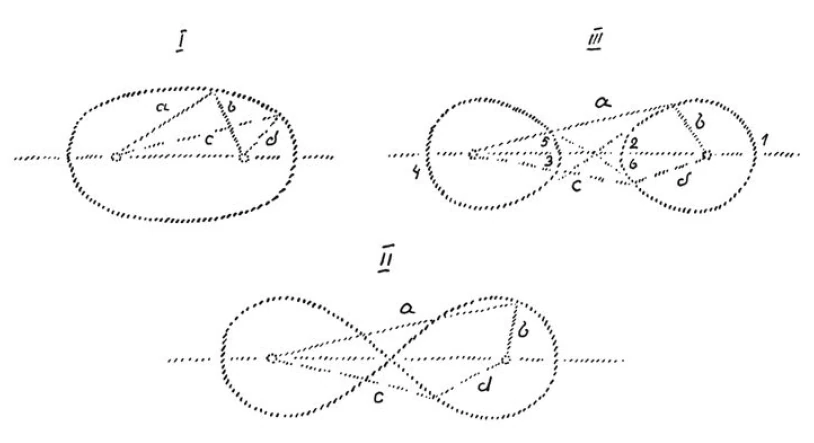
Ja, sehen Sie, das sind wieder zwei Linien, aber innerlich ist es bloß eine Linie, und wenn man im Astralischen sie als eine Linie empfindet, so weiß man, daß diese Form [III] nur ein spezieller Fall ist von der Form [II]. Aber denken Sie sich: die Überkreuzung verschwinde nun in die vierte Dimension und mit ihr die Linie [bei 2] - nun kommt die Linie wieder heraus [bei 3] und kommt in das Physische, - nun verschwindet sie wieder [bei 5], nun kommt sie wieder heraus [bei 6]. Dadurch ist sie eins, daß sie immer wieder verschwindet in die vierte Dimension. Man kann sagen, diese Linie der Multiplikation hat schon drei verschiedene Formen.
Wir haben also eine Linie der Addition, eine Linie der Subtraktion, eine Linie der Multiplikation. Nun kann einer sagen, es müsse ja auch eine Linie der Division geben, der vierten Rechnungsart. Da müßte man die zwei Entfernungen dividieren, anstatt addieren, subtrahieren oder multiplizieren. Das heißt, es müßte möglich sein, daß unser Astralleib sich zwei Punkte fixiert, und nun irgendwie andere Punkte. Wenn er die größere Linie nimmt [a], und sie dividiert durch die kleinere [b], bei dem Punkt wiederum die größere [c] durch die Kleinere [d] und so weiter, so kriegt er auch eine Linie, nämlich diese [Kreis]. Alle Punkte sind so gewählt, daß ihre Abstände von zwei Punkten bei der Division dasselbe geben.
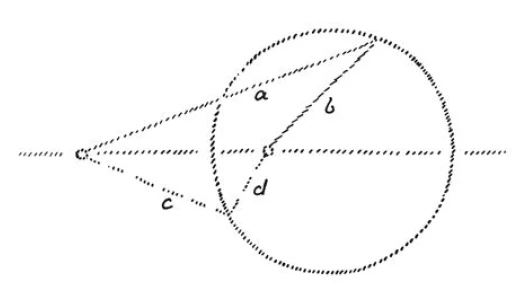
Das heißt:
Wir addieren und bekommen die Ellipse,
wir subtrahieren und bekommen die Hyperbel,
wir multiplizieren und bekommen die Cassinische Kurve, Lemniskate,
wir dividieren und bekommen den Kreis.
Und nun haben wir etwas höchst Merkwürdiges; höchst merkwürdig ist das, was ich jetzt sage. Wenn man wirklich versucht, in die Tiefen der Natur einzudringen, so treten sie einem ganz merkwürdig vor die Seele. Wenn man den Kreis so anschaut, so sieht man, er ist ein ganz banaler Wicht, er ist etwas ganz Triviales; aber es liegt doch etwas Geheimnisvolles im Kreis. Er kann auch dadurch verstanden werden, daß man zwei Punkte nimmt und dividiert, und indem man überall dasselbe Resultat bekommt bei der Division, ergibt sich der Kreis. Der Kreis ist also etwas ganz Merkwürdiges: der gewöhnlichste Wicht, den man leicht überschauen kann, und zugleich das Ergebnis einer okkulten Division, das sich der Mensch zum Bewußtsein bringt. Geradeso ist es bei dem menschlichen Selbst: das gewöhnliche Selbst, der alltägliche Wicht, und das höhere Selbst, das Geheimnisvolle, das in den Tiefen unserer Seele ruht und das erst gesucht werden muß dadurch, daß man aus ihm herausgeht und die Welt in Betracht zieht, mit der es in Beziehung steht. Wie der Kreis dasselbe ist, wenn wir sagen: er ist etwas ganz Triviales, er ist die einfachste Form - oder wenn wir sagen: er ist so, daß das Ergebnis der Division von zwei Punkten immer dasselbe ist -, wie wir denselben Kreis haben, so haben wir in uns selbst ein Zweifaches vor uns: das, was der Alltäglichkeit angehört, was leicht überschaubar ist, und das, was man nur begreift, wenn man zur ganzen Welt hinausgeht, wenn man es sozusagen als das komplizierteste Ergebnis des großen Weltenkampfes auffaßt, wo Ahriman und Luzifer die Division ausführen, gegenüber welcher sich als Quotient zu halten hat unser höheres Selbst, wenn es eben zum Ausdruck kommen will.
Stücke von der Ellipse, Stücke von der Hyperbel werden Sie in unserem Bau überall finden; aber auch Stücke der Cassinischen Kurve, der Lemniskate, werden Sie an unserem Bau finden, und Ihr Astralleib wird in diesem Bau genügend Gelegenheit haben, solche Operationen zu machen. Ich will nur das eine erwähnen: Wenn einmal in unserem Bau die Menschen zur Brüstung sehen werden, wo die Orgel steht und wo die Sänger sein werden, dann wird die Seele Gelegenheit haben, diese Multiplikation auszuführen, wenn die Seele es auch nicht weiß, aber in ihren Tiefen erfühlt sie das, weil die Linie des Umbaues um die Orgel diese Linie ist. Diese Linie findet sich vielfach an unserem Bau.
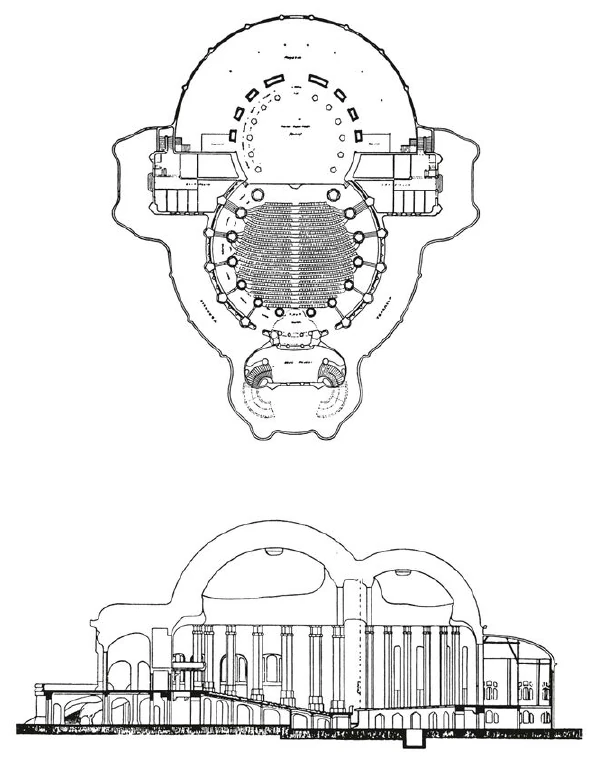
Nach dem, was ich jetzt mitgeteilt habe über die doppelte Bedeutung des Kreises, wird es Ihnen naheliegen, zu sagen: Nun also, ich trete von Westen herein in unseren Bau, ich fühle mich umfangen von dem kreisrunden Bau, von dem kugeligen Abschluß nach oben. Das ist einfach zu überschauen, es ist das Abbild des menschlichen Selbst. Aber nun werde ich hinblicken in den Nebenbau, der etwas kleiner ist, der wird mir nicht sofort so verständlich sein. - Man wird schon fühlen: da ist etwas, was geheimnisvoll ist. Das rührt davon her, daß es auch die Kreisform ist, die aber so vorgestellt werden muß, daß sie das Ergebnis einer Division ist und dem anderen Raum nur äußerlich vollkommen gleich ist. Kreis und Kreis: Das eine aber ein Kreis, der dem Alltag sich anpaßt, das andere ein Kreis, der mit der ganzen Welt in Beziehung steht. So wahr wir in uns tragen niederes, gewöhnliches Selbst und höheres Selbst, und sie doch wieder eins sind, so wahr mußte unser Bau ein Doppelbau werden. Dadurch drückt er aus in seiner Form - nicht in symbolischer Weise, sondern in der Form selbst - die zwei Naturen des Menschen. Und indem man sich bei geöffnetem Vorhang im Bau fühlen wird, wird man ein Abbild des Menschen, nicht nur wie er im alltäglichen Leben ist, sondern des ganzen Menschen erfühlen. Und indem das der Fall ist, was gesagt worden ist, daß die Formen etwas wie eine Bewegung ausdrücken von Westen nach Osten, ist der Gang des gewöhnlichen Selbst zum höheren Selbst unmittelbar in der Form ausgedrückt.
Alle die Dinge, die ich jetzt ausgesprochen habe, sind so, daß sie in den Formen wirklich gefühlt werden können. Und indem einmal ein Bau dieser Art ausgeführt wird, wird gezeigt, wie die geistige Form der Natur und die höhere Geisteswelt auf naturgemäße und geistgemäße Weise zum Ausdruck kommen können. Nicht der wird unseren Bau verstehen, der anfängt zu spintisieren und allerlei ausdenken wird, sondern der, der lebendig fühlen wird; der fühlen wird das Werden der Formen und das Sein der Formen. Deshalb will ich auch nicht in bildlichen Ausdrücken sprechen von dem Bau, sondern so, wie er entstanden ist, wie wirklich das geistige Wesen Form geworden ist und Bewegung geworden ist und in unseren Bau eingeflossen ist. Und wenn nun einfach jemand spintisieren würde, etwa einmal sich den Bau von innen ansehen würde und sagen würde: Ja, zwei Kuppeln, zwei Rundbaue: niederes Selbst und höheres Selbst, ein niederes, ein höheres Selbst, also ein Einheit -, nun, dann könnte das ja eine ganz niedliche Spekulation sein, aber sie wäre nicht mehr wert als wenn jemand sagen würde: Nun, Maria und Thomasius in den Mysterienspielen sind eigentlich nur eine einzige Wesenheit. — Wer so sagt, der spintisiert, denn er erklärt etwas für eine abstrakte Wesenheit. Die Einheit liegt im lebendigen Werden. Selbstverständlich können die lebendigen Werdekräfte Maria und Thomasius hervorbringen, aber nur durch die Differenzierung. Und selbst bei dem Gleichen wird der wahre Okkultist nach den Mannigfaltigkeiten suchen, während es ein schlechter Okkultismus wäre, das Mannigfaltige auf eine Einheit zurückführen zu wollen. Deshalb das Beispiel vom Kreis. Der Kreis ist nicht bloß ein Kreis, sondern der Kreis ist zwar das Allereinfachste: alle Punkte von einem Mittelpunkt gleich weit abstehend; aber er ist auch zugleich das Ergebnis einer Division. Da haben Sie das, was in der Außenwelt eine Einheit ist und zum Komplizierten der geistigen Welt wird.
Das sind so einige Bemerkungen, die ich habe machen wollen; andere werden wir noch machen bei einer anderen Gelegenheit, wenn ich noch über den Bau als solchen sprechen werde. Nun möchte ich von einer anderen Seite her ein paar andere Betrachtungen vor Ihre Seele rufen.
Der Mensch, wie er als Mensch in die Welt tritt, ist eigentlich ein sehr kompliziertes Wesen. Wenn er so als Mensch in die Welt tritt - ich habe das ja schon oft erwähnt -, dann kann er zunächst nicht aufrecht stehen. Er kriecht; anfangs kriecht er sogar nicht einmal. Er lernt nach und nach die Kräfte bemeistern, die ihn aufwärts bringen. Versuchen wir einmal schematisch auf zuzeichnen, was da eigentlich vorliegt: Hier [es wird zu zeichnen begonnen] die Erde. Der Mensch, zunächst ein horizontales Wesen; er richtet sich auf, wird vertikal. Das ist eine Errungenschaft der menschlichen Natur selbst, sich in die Vertikale zu stellen. Nun, wer tut denn das eigentlich? Ich sagte: Es ist ein Ergebnis der menschlichen Natur selbst. Aber der Mensch hat Hilfe, Hilfe von allen Hierarchien, indem er seinen Lebenslauf durchläuft. Was kommt ihm denn zu Hilfe, wenn er sich zum Stehen, zum Gehen erhebt? Zu Hilfe kommen ihm die Kräfte, die aus der Erde heraus wirken gegen die Weiten des Weltenraums zu. Diese Kräfte stellen Kräfte der Erde dar. Heute sprechen die Physiker nur von solchen Kräften der Erde, die eben physikalische Kräfte sind: Anziehungskraft, Schwerkraft. Aber die Erde ist nicht bloß ein physikalischer Körper, sondern ein geistig-seelisches Wesen, und indem wir uns als Kind zum Aufrechtgehen aufrichten, da vereinigen wir uns mit den Willenskräften, die aus der Erde herausdringen. Der Wille der Erde durchdringt unser Sein. Wir lassen den Willen der Erde in uns einfließen und stellen uns in die Richtung des Willens der Erde aufrecht hinein. Verbündung mit dem Willen der Erde ist es. Aber dem Willen der Erde ist gegnerisch ein Wille, der vom Weltenall hereinwirkt, und der wirkt von allen Seiten herein. Indem wir uns aufrichten, wissen wir es zwar nicht, aber es ist der Fall. Es wirken überall, von allen Seiten, die Kräfte herein. Wir stoßen, indem wir uns aufrichten, immer an solche Kräfte an, die von außen hereinkommen.
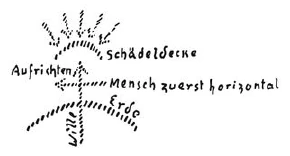
Heute hat das auf der Erde keine besondere Bedeutung mehr, aber auf dem alten Mond hatte es noch eine große, eine riesengroße Bedeutung. Nämlich auf dem Mond war es so, daß der Mensch in einer gewissen Weise von seiner ersten Kindheit an bis später eine andere Richtung angenommen hat, daß er sich in die Willensrichtung des Mondes hineinzustellen hatte. Dadurch hat er die erste Anlage bekommen zu der Schädeldecke. Heute haben wir sie schon ererbt, aber auf dem Mond mußten wir sie uns noch erwerben. Da arbeiteten wir in uns gegen die äußeren Willenskräfte. So etwa, wie eine Lokomotive arbeitet, wenn sie Schnee zurückschieben muß, so schob der Mensch die Willenskräfte des Kosmos zurück, und dadurch preßte sich sein weicher Schädel zur Schädeldecke. Heute brauchen wir das nicht mehr, heute ist es Vererbung; wir brauchen nicht mehr die Schädelknochen zu bilden. Aber im Ätherleib, da bilden wir sie noch, indem wir uns aufrichten, da verdichtet sich das hier auf dem Kopfe noch, was Ergebnis ist des Kampfes zwischen den Kräften, die von der Erde ausstrahlen, und den Kräften, die von allen Seiten herankommen. So daß wir sagen können: Wenn wir den Ätherleib betrachten, da finden wir noch, daß der Mensch mit den beiden Beinen gerade Linien aufrichtet und entgegenarbeitet den Kräften, die von außen kommen. Und der Ätherleib wird verdichtet, so daß wir sagen können: da entsteht diese Form. Wir richten uns auf. Die physischen Beine haben oben ihre Verbindung, die Ätherbeine gehen weiter hinauf. Dadurch verdichtet sich hier der Ätherleib des Kopfes, und durch die Bildung des Gehirns entsteht auch heute noch im Ätherleib der verdichtete Ätherkopf. Aber nicht nur geschieht das im Kindesalter, sondern, indem der Mensch sieben Lebensperioden durchmacht - vom ersten bis siebten Jahr, vom siebten bis vierzehnten Jahr und so weiter -, da bilden sich immer neue Linien, solche verschiedengeartete Kräfte, die nach oben gehen. So daß, wenn wir das Alter erreicht haben, von dem wir ja schon sagen dürfen, daß wir durch dieses Alter wirklich im vollen Sinne des Wortes Mensch geworden sind, wenn wir das fünfzigste Lebensjahr überschritten haben - nicht wahr, das ist schon eine ganz respektable Menschheit -, dann haben wir zu den ersten starken Säulen, die wir während der ersten sieben Jahre gebaut haben, immer weitere Säulenpaare hinzugefügt. Im Ätherleib zeigen sie sich in verschiedenen Farben. Und jedesmal machen wir unsere Ätherdecke stärker, indem wir diese - man möchte sie «Lebenssäulen» nennen -, indem wir diese Lebenssäulen ausbilden. Mit den ersten sieben Jahren ist das erste Paar abgeschlossen, mit dem vierzehnten Jahr das zweite Paar, mit dem einundzwanzigsten Jahr das dritte Paar, mit dem neunundvierzigsten Jahr endlich das siebente Paar. Und mit jedem Paar solcher Lebenssäulen tragen wir sicherer unsere ätherische Schädeldecke.
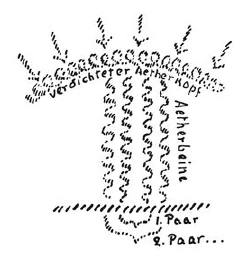
Brauchen Sie noch mehr, als sich vorzustellen, daß der Mensch anfängt zu leben, daß er das Leben durchwandert, und nach je sieben Jahren verschieden gestaltete Säulen in sich aufrichtet, die seine Schädeldecke tragen?! Brauchen Sie mehr? Sie brauchen nicht mehr. Wenn Sie das nehmen, haben Sie lebendig erfaßt die innere Form unseres Baues, was den größeren Rundbau betrifft. Sie gehen im Westen hinein und sagen sich: Jetzt ist es so bis zum ersten Säulenpaar, wie der Mensch sich entwickelt in seinen ersten sieben Lebensjahren; weiter ist es so bis zum zweiten Säulenpaar, wie der Mensch sich entwickelt bis zum vierzehnten Lebensjahr, noch weiter bis zum einundzwanzigsten Lebensjahr und so weiter, und immer haben Sie um sich die ätherische Decke Ihres Hauptes; Sie haben den lebendigen Menschen in die Formen ergossen, aber so, wie er ist, wie er lebt in seinem Ätherleibe.
Sehen Sie, das wird der Fortschritt von der Gotik zur geisteswissenschaftlichen Baukunst sein: In der Gotik war das Gebet: «O Vater der Welt, laß uns mit Dir in Deinem Geiste vereinigt sein!» So ist die Gotik geformt. Und diejenigen, die sich dazu bequemen werden, das anzunehmen, was diesem Gebet gewährt wird, die wirklich verstehen die lebendige Entfaltung der Geisteswissenschaft, die werden enträtseln das Rätsel des Menschen in seinem Werden. Und dann wird der Mensch - nachdem die Formen des baukünstlerischen Gedankens gestrebt haben, sich mit dem Geiste zu vereinigen, aber zunächst das Streben darstellend -, dann wird er fühlen, wie er als Mensch durchgeistigt wurde von dem verborgenen Geiste, und als Umhüllung ein Haus um sich haben kann, das unmittelbar das menschliche Wesen zum Ausdruck bringt, das menschliche Wesen in seinem inneren, seinem lebendigen Werden erfaßt.
«Wir leben in der Landschaft, aber der Geist ist unter uns» — so sagte der griechische baukünstlerische Gedanke.
«Wir leben im Hause, oder besser gesagt, wir
«Wir weilen im Hause, aber wir erheben die Seele dadurch, daß wir uns ahnend zum Geiste erheben», - das ist der gotische baukünstlerische Gedanke.
«Wir gehen in Verehrung in den Geist ein, auf daß wir eins werden mit dem Geiste, der sich ausgießt um uns herum in den Formen, weil um uns herum die Geister der Form sind, und der in Bewegung kommt, weil hinter den Geistern der Form die Geister der Bewegung stehen», - das ist der neue baukünstlerische Gedanke!
So schreitet das Dasein über die Erdenentwickelung hin, und der Mensch hat die Aufgabe, den inneren Sinn und die innere Bedeutung dieses Daseins zu erfassen. Er geht nur dann mit der wirklichen Entwickelung mit, wenn er sich bemüht, in jeder Zeit mitzuerleben das, was ihm die geistige Welt gerade für die Entwickelungsepoche seiner Zeit gibt.
Warum gehen wir als Seelen durch verschiedene Inkarnationen, durch die aufeinanderfolgenden Inkarnationen? Nicht deshalb, um immer dasselbe zu erfahren, nicht deshalb, um immer wiederum und wiederum Renaissance nach Renaissance zu erleben, sondern um immer das Neue, das aus den geistigen Welten sich ergießt, in unsere Seelen aufzunehmen. In dieser Beziehung stehen wir wirklich an einem Punkte der Menschheitsentwickelung - auch in künstlerischer Beziehung, und in mancher geistiger Beziehung -, in dem deutlich der Geist zu uns von neuen Rätseln spricht. Und so, wie sich in der Zeit der Renaissance der Mensch zunächst nur orientieren sollte an dem, was vergangen war, um sich hindurchzuarbeiten zu etwas Neuem, so ist es auch mit unserem äußeren Welterkennen und Weltenfühlen. Dasjenige, was die neuere Zeit seit dem 16. Jahrhundert gebracht hat, das war gerade die Vorbereitung nur zu dem Erfühlen der Welt in ihren Formen und in ihren Bewegungen, die jetzt wie Rätsel vor uns stehen.
Dies für heute. In einer nächsten Betrachtung werde ich versuchen, eine noch intimere Frage anzugreifen: was uns wird bezüglich des Verhältnisses der lebendigen Seele durch die ganze Natur hinurch, wenn wir die Farbe, und mit der Farbe die malerische Kunst ins Auge fassen.
6. The New Architectural Concept
My dear friends! I think it is quite good if, as we continue with our building, we try to grow further and further into its meaning. We have already begun to do so with the two observations we have made, and we will try, as best we can, to continue doing so in the coming days with further observations, in order to become, so to speak, one with what is to be created here.
First of all, I would like to remind you of a remark I made on the occasion of the opening of the house that is to be dedicated to the design of the windows for our building. This remark referred to the development, I would say, of the architectural idea, the architectural concepts. I would like to briefly recapitulate what I was able to remark on this subject, albeit only in a suggestive manner.
It has been said of the Greek temple that it forms, as it were, a unity with the entire landscape, that it inserts itself into the entire landscape, and that the landscape has actually grown together with it, so that the temple is “the dwelling place of the god” , that nothing needs to be in this temple except the spiritual presence of the god and his physical image, and that the essence of the temple's design is based on the fact that, as it were, every person in their daily activities in the landscape knows: within the area where I perform this or that work, I am not alone with the earth, but I am together with the spiritual world. And the symbol of the fact that, simply by inhabiting the earth, we are together with the spiritual world is the fact that the temple stands in the landscape like an altar.
We have then seen how a certain progress in architectural thought lies in the fact that Christian architecture separated the building from the landscape, that, in a sense, everyday life and the elevated mood through which one rises to the spirit become two, so that the Christian building is no longer actually one with the landscape, but because it serves the spirit separately from the landscape, it now expresses, as it were: if man is to rise to the spirit, then he must go out of everyday life, he must stay in a separate place and be united with the spirit there. - As a result, Christian architecture could no longer be what Greek and even Roman architecture was, but became a duality in itself: the house of the community and the separate house for the altar and the priesthood. Man has stepped out of everyday life and onto the ground where he feels himself looking up to the spirit, and the spirit comes to meet him through the enclosure of the altar.
With this further development of architectural thought, it goes without saying that the old Greek building form, which grew purely out of static and dynamic conditions, out of conditions of space and gravity, as I have indicated, was transformed into a form that, in a sense, adapted to the idea of separation of the community.
And if we then move on to the Gothic cathedral, we have, as it were, another form of architectural thought. We have the community's aspiration to bring not only the individual's own personality into the temple, but also the individual's work; and this is expressed in the forms of Gothic architecture. One senses, as it were, how what has been worked in the surroundings has been brought together in the architectural forms and rises like a prayer, like hands clasped in supplication, to the spiritual.
I then said how real progress in architectural thought must now take place again in our time, and how it can only take place if the approach to the spiritual, which has increasingly taken place from Greek to Gothic architectural thought, gradually transforms into a becoming one with the spirit. This means that the house, which must now be dedicated to living together with the spirit, must represent an intimate communion of form with the spiritual itself. One could then say, if one is not tempted to think of the matter in purely abstract terms, but can embrace it with one's whole feeling, with one's whole soul: Everything that lives into our soul through spiritual science is once again life in the form we create. The spirit appears free, as if it has now descended to man.
While the Greeks placed the temple in the landscape like an altar, the future and — insofar as we work from this future with our building — the present place the spirit itself in its form of expression into the landscape. And then, of course, through what the spirit expresses in its forms, there must be something that speaks to the people of the present like a language, as I have indicated several times. But for all this, my dear friends, it is necessary that we try to understand the spirit in its form-giving. In order to understand the Greek temple, we tried last time, I would say, to clarify for ourselves the purely physical aspects of space and gravity. But the spirit is not merely a mechanic and a dynamist; it does not reveal itself only in spatial and force relationships. The spirit is alive, and the consequence of this is that its expression in the building is a living one, a truly living one. We will not understand what I have said better by now beginning to interpret the spirit in a symbolic way, but by beginning to really feel the forms as living, by perceiving the forms as organs of speech from the spiritual world.
Can forms speak from the spiritual world? Forms can speak in many ways from the spiritual world. Let us take a thought that is particularly close to us at the moment, because on the one hand it is the expression of the highest, and on the other hand, in its Luciferic character, it plunges into the lowest: the thought of the I, the thought of selfhood.
It cannot be denied that when we simply utter the word “I,” “our self,” human beings are not yet able to think very much. Many epochs will have to pass in human history before a fully conscious idea awakens in the soul when the word “I” or the word “self” is uttered. But selfhood, egohood, can be felt in form, and when one moves from purely mathematical knowledge of form to feeling form, one will always feel egohood, selfhood, in the complete circle. To feel the circle would mean to feel selfhood. To feel the circle in the plane, to feel the sphere in space, is to feel selfhood, to feel the ego. Once you realize this, you will easily understand the rest. If you realize that, basically, when a truly sensitive person stands before a circle, the feeling of selfhood, the feeling of individuality, arises in their soul, so that when they see the circle, or only a piece of the circle, or when they see a small piece of the sphere's shell, they feel that this points to the “feeling of self-existence.” When a person feels this way, they learn to live in forms. And it is, in a sense, the characteristic of living feeling to be able to live in forms. Now, if you consider this, you will be able to move on to the next point with ease.

As I have drawn the circle here, it is initially completely unstructured [1]. However, it can be structured in two ways, so that it projects such protrusions [2]. That would be one structure. Another characteristic structure would be this [3]. Both forms are actually just structured circles. What do these structures mean? This structure [2] means that the self, the I, has entered into a relationship with the outside world. When we face the bare circle, we may feel that the rest of the world is not there, that only what is enclosed in the circle is there. When we look at the structured circle, we can no longer feel that what is expressed by the circle is alone in the world. The structure of the circle expresses a struggle, a kind of interrelationship with the outside world. And it is characteristic that those who empathize with the form of the articulated circle [2] feel that the interior is stronger than the exterior! And with the jagged circle [3]: the outside has dug in and is stronger than what lies within the circle. And if we now walk through any space that has pieces of circle lines or spherical surfaces and notice such articulations, we can, simply by following the lines, have the feeling from the jagged line: Ah, here the outside prevails! And with the wavy line: Ah, here the interior prevails! And our soul begins to experience the form. We don't just look at it, but we have the vivid, ebbing and flowing feeling of “overcoming and transgression,” “overcoming and defeat in the soul,” that is, our soul becomes alive, it lives with the form. And that is the essence of artistic feeling, this becoming one with the form, this living with the form.
But we can go further. Don't think of the structure as simple as it is here, but rather as [4]:

That is, the form moves in one direction and it is action. My dear friends, anyone who immerses themselves in this form to any degree immediately has the feeling that it continues, that it moves. Thus, we find the characteristic of movement in the forms themselves.
I have described to you here in a simple way something that you will find complicated in the building, but you will nevertheless find a very definite unity. Namely, if you imagine the west entrance and you were to proceed toward the small room, you would find all the forms inside the room in such a way that they would evoke the feeling of the whole moving from west to east. This is expressed in the forms. You will sense this ideally in your mind as you enter the building from the west, so that you will say to yourself: I am now in the vehicle that is taking me to the spiritual east. And that is the meaning of the relief structures, that they do not merely receive us as dead dynamic or mechanical forms, but that we enter, as it were, into a vehicle, into a carriage that carries us onward. Spiritually, it is not true, spiritually, of course, it is not true that when we are inside, in our building, we will rest there; but spiritually, we will be carried onward, in expression, in meaning.
You can see from this that the whole basic character of the form here is different from the basic character of those forms that were present in the three stages of architectural thought that I have described. Until now, architectural thought has been the thought of the resting, lifeless, mechanical; but now architectural thought is beginning to become the thought of speech, the thought of inner movement, the thought of that which carries us away. And that is to be the new thing in the whole thought in relation to this one aspect. The basic form must, of course, correspond to this. How does the basic form correspond to it?
Well, I have said, my dear friends, that the self, the I, is basically the most obvious impression, namely the impression of the circle or sphere. Why is that? Well, because basically the simple sphere or the simple circle is the most obvious thing, the most obvious thing of all. You need very little to recognize something as a circle. What does one need to recognize something as a circle? Well, one needs nothing more than, I would say, the most banal thought there can be: that something is equidistant from its center everywhere. As soon as one imagines: here are points everywhere that are equidistant from a central point, one has an overview of the sphere or the circle. It is the easiest thing one can do in one's mind. So one can say: the circle as a shape is the least mysterious thing there is. And ultimately, this also corresponds to external reality, because the selfhood with which every being appears, from the simplest cell to the most complex human being, is the most everyday impression, the simplest impression, just as the impression of the spherical, the circle, is the simplest impression.
But there is something deeper behind all this, and I ask you now to follow me in pursuing a thought that, for those who understand it clearly, can contain something extraordinarily profound. I ask you to follow me in the following thought.
You see, a slightly more complicated shape than the circle is the ellipse. I want to draw the ellipse very simply, as we are accustomed to seeing it; it does not need to be an exact ellipse, but only to have the general shape of an ellipse. The trivial simplicity of the idea leaves us when we move from the circle to the ellipse. There is no longer equality, but regularity is still present in the ellipse, and I must ask those who have studied geometry—let us politely assume that everyone has studied it, but that they have already forgotten some of it—to familiarize themselves with the following idea:

There is also regularity in the ellipse. Just as the circle has a relationship to one point, the ellipse has a relationship to two points. And if you look at any point on the ellipse and draw a line connecting it to the two points, these lines are of course completely different from each other, but whenever you draw a line here and take one piece from the ellipse to one point and mark it there, and you take the other piece and mark it next to it, and you now take this and the other piece, it always gives the same length. So you can add up the distance of each point from these two points, and you always get the same length. It's so simple with a circle that we don't need to think about it. But now we have to add. With a circle, all the lines are the same up to the center; here we first have to think about adding.
Now, of course, you may say: Yes, but I don't add anything up when I see an ellipse. - You don't, but the astral body does, and what the geometer does consciously, the astral body does unconsciously. It is, in fact, a fully-fledged geometer. And you have no idea, if you'll pardon the expression, about everything you know in your astral body; you are an immensely wise geometer, except that what you know in your astral body about this geometry only comes into consciousness—pardon the expression, but today it is allowed... [it was very hot that day] — only through sweating does it come out into consciousness, if one wants to acquire it in consciousness. But down there in the astral body, it's all there, and if geometry teachers could use a press or a pump instead of the methods they have to pump up what is in the astral body, then they wouldn't need to teach. Everything would come up by itself. So you add the two distances from the two points and always get the same result. And what does it mean, deep down, to find an ellipse beautiful? It means that my astral body adds up and always gets the same sum. And now imagine that you add up without knowing it and get the same sum every time: that makes you a little happy. And now you go to this point: Oh joy, the same sum! You go to this point: Oh joy, the same sum! That is what it means to experience the ellipse in a living way.
The circle gives us the least joy because it is trivial and easy to overlook. The ellipse gives us greater joy because it requires us to be active internally. And the more you have to be active internally, the happier you are. This is precisely what many people find so difficult to understand, that human beings actually want to be active internally; if they want to be lazy, it is only in their consciousness. Their astral body is not only wiser, but also more industrious; it always wants to be active.
Now there is another line, which always consists of two pieces. Those who know geometry know why. It consists, as it were, of two symmetrical branches — this is the hyperbola. It also has two such points, which lie approximately here. Now we can again draw lines to these two points. The peculiar thing is that we do not add, but subtract. We always get the same result when we subtract the smaller from the larger. Our astral body subtracts and is pleased that the difference always remains the same. In this inner feeling of equality, our astral body experiences the emergence of the hyperbola.

So we are calculators in the depths of consciousness, and through unconscious calculation we obtain the regularity of form. We add and subtract. But we can also multiply. This happens in such a way that we again have two points. Then, when multiplying, it must be like this: if we multiply this with that and that with that, we again get a line that looks similar to the ellipse, but is not the same. This line [T] therefore contains an internal multiplication. This line already has something mysterious about it. The circle is a rather trivial thing, the ellipse is more complicated, and the hyperbola is even more complicated, because I believe that the average person does not even see a single line in the two branches; the average mind believes that there are two lines, but they are not. This line is mysterious in another way, because depending on the result of the multiplication, this line [T] changes into this strange form [II]. This is the same line, the multiplication line, the lemniscate, which plays such an important role in all occult investigations. And it can go so far with the line that it takes on this form [III].

Yes, you see, these are two lines again, but internally it is only one line, and when you perceive it as one line in the astral, you know that this form [III] is only a special case of the form [II]. But think about it: the intersection now disappears into the fourth dimension, and with it the line [at 2]—now the line comes out again [at 3] and enters the physical realm—now it disappears again [at 5], now it comes out again [at 6]. It is one because it keeps disappearing into the fourth dimension. One can say that this line of multiplication already has three different forms.
So we have a line of addition, a line of subtraction, and a line of multiplication. Now one might say that there must also be a line of division, the fourth type of calculation. There one would have to divide the two distances instead of adding, subtracting, or multiplying them. That means it should be possible for our astral body to fixate on two points and then somehow on other points. If it takes the larger line [a] and divides it by the smaller [b], and at that point again the larger [c] by the smaller [d], and so on, it also gets a line, namely this [circle]. All points are chosen so that their distances from two points give the same result when divided.

That means:
We add and get the ellipse,
we subtract and get the hyperbola,
we multiply and get the Cassini curve, lemniscate,
we divide and get the circle.
And now we have something most remarkable; what I am about to say is most remarkable. If one really tries to penetrate the depths of nature, they appear before the soul in a most remarkable way. When you look at the circle, you see that it is a very banal thing, something quite trivial; but there is something mysterious about the circle. It can also be understood by taking two points and dividing them, and by getting the same result everywhere in the division, the circle is obtained. The circle is therefore something quite remarkable: the most ordinary thing, which is easy to overlook, and at the same time the result of an occult division that humans bring to consciousness. It is exactly the same with the human self: the ordinary self, the everyday creature, and the higher self, the mysterious one that rests in the depths of our soul and must first be sought by stepping outside of it and considering the world with which it is connected. Just as the circle is the same when we say it is something quite trivial, it is the simplest form — or when we say it is such that the result of the division of two points is always the same — just as we have the same circle, so we have a duality within ourselves: that which belongs to everyday life, which is easily comprehensible, and that which can only be understood when one goes out into the whole world, when one understands it, so to speak, as the most complicated result of the great world struggle, where Ahriman and Lucifer carry out the division, in relation to which our higher self must stand as the quotient if it wants to express itself.
You will find pieces of the ellipse, pieces of the hyperbola everywhere in our building; but you will also find pieces of the Cassini curve, the lemniscate, in our building, and your astral body will have ample opportunity to perform such operations in this building. I will mention just one thing: once people in our building see the balustrade where the organ stands and where the singers will be, the soul will have the opportunity to perform this multiplication, even if the soul does not know it, but feels it in its depths, because the line of the reconstruction around the organ is this line. This line is found many times in our building.

After what I have now communicated about the double meaning of the circle, it will be obvious to you to say: So, I enter our building from the west, I feel enveloped by the circular building, by the spherical top. This is easy to see, it is the image of the human self. But now I will look at the annex, which is somewhat smaller, which will not be immediately understandable to me. One will already sense that there is something mysterious about it. This stems from the fact that it is also circular in shape, but must be imagined as the result of a division and only outwardly identical to the other space. Circle and circle: one a circle that adapts to everyday life, the other a circle that relates to the whole world. As surely as we carry within us a lower, ordinary self and a higher self, and yet they are one again, so surely our building had to become a double building. In this way, it expresses in its form – not in a symbolic way, but in the form itself – the two natures of man. And when one feels oneself in the building with the curtain open, one senses an image of the human being, not only as he is in everyday life, but of the whole human being. And since this is the case, as has been said, that the forms express something like a movement from west to east, the passage of the ordinary self to the higher self is directly expressed in the form.
All the things I have now spoken of are such that they can really be felt in the forms. And once a building of this kind is constructed, it will show how the spiritual form of nature and the higher spiritual world can be expressed in a natural and spiritual way. It is not those who begin to speculate and think up all kinds of things who will understand our building, but those who feel it alive; who will feel the becoming of the forms and the being of the forms. That is why I do not want to speak of the building in figurative terms, but rather in terms of how it came into being, how the spiritual essence truly took form and became movement and flowed into our building. And if someone were to simply speculate, perhaps looking at the building from the inside and saying: Yes, two domes, two round buildings: lower self and higher self, a lower self, a higher self, thus a unity — well, that might be a very cute speculation, but it would be no more valuable than if someone were to say: Well, Maria and Thomasius in the Mystery Plays are actually only one single entity. — Anyone who says this is speculating, because they are declaring something to be an abstract entity. Unity lies in living becoming. Of course, the living forces of becoming can bring forth Mary and Thomas, but only through differentiation. And even in the same, the true occultist will seek diversity, while it would be bad occultism to want to reduce diversity to unity. Hence the example of the circle. The circle is not merely a circle, but the circle is indeed the simplest thing: all points equidistant from a center; but it is also the result of a division. There you have what is a unity in the outer world and becomes the complexity of the spiritual world.
These are a few remarks I wanted to make; we will make others on another occasion, when I will talk about the building as such. Now I would like to call to your attention a few other considerations from a different perspective.
The human being, as he enters the world as a human being, is actually a very complicated creature. When he enters the world as a human being — as I have often mentioned — he cannot stand upright at first. He crawls; in the beginning, he does not even crawl. He gradually learns to master the forces that bring him upward. Let us try to sketch out schematically what is actually happening here: Here [the drawing begins] is the earth. Man, initially a horizontal being, straightens up and becomes vertical. It is an achievement of human nature itself to stand upright. Now, who actually does that? I said: it is a result of human nature itself. But man has help, help from all hierarchies, as he goes through his life. What comes to his aid when he rises to stand and walk? The forces that work out of the earth toward the vastness of space come to his aid. These forces represent the forces of the earth. Today, physicists speak only of those forces of the earth that are physical forces: gravitational pull, gravity. But the earth is not merely a physical body, but a spiritual-soul being, and when we rise to stand upright as children, we unite ourselves with the forces of will that emanate from the earth. The will of the earth permeates our being. We allow the will of the Earth to flow into us and stand upright in the direction of the Earth's will. It is a union with the will of the Earth. But the will of the Earth is opposed by a will that comes in from the universe, and that works in from all sides. When we stand upright, we do not know it, but it is the case. Forces are working in everywhere, from all sides. By standing upright, we always encounter such forces coming in from outside.

Today, this no longer has any special significance on Earth, but on the old Moon it still had a great, enormous significance. Namely, on the Moon, it was the case that human beings, in a certain way, took a different direction from their early childhood onwards, that they had to align themselves with the will of the Moon. This gave them the first predisposition to the skull cap. Today we have already inherited it, but on the moon we still had to acquire it. There we worked within ourselves against the external forces of will. Just as a locomotive works when it has to push back snow , so did human beings push back the forces of will of the cosmos, and in this way their soft skulls pressed themselves into the cranial vault. Today we no longer need to do this; today it is hereditary; we no longer need to form the skull bones. But in the etheric body we still form them by standing upright, and this condenses here on the head as a result of the struggle between the forces radiating from the earth and the forces approaching from all sides. So we can say that when we look at the etheric body, we still find that the human being stands upright with both legs in straight lines and works against the forces coming from outside. And the etheric body becomes denser, so that we can say: this form arises. We stand upright. The physical legs have their connection at the top, the etheric legs go further up. This causes the etheric body of the head to condense, and through the formation of the brain, the condensed etheric head is still formed in the etheric body today. But this does not only happen in childhood; as human beings go through seven periods of life — from the first to the seventh year, from the seventh to the fourteenth year, and so on — new lines are constantly being formed, different kinds of forces that go upwards. So that when we have reached the age at which we can truly say that we have become human beings in the full sense of the word, when we have passed the age of fifty — which is already a very respectable age — then we have added more and more pairs of pillars to the first strong pillars that we built during the first seven years. In the etheric body, they appear in different colors. And each time we strengthen our etheric covering by forming these – one might call them “pillars of life” – by forming these pillars of life. The first pair is completed in the first seven years, the second pair in the fourteenth year, the third pair in the twenty-first year, and finally the seventh pair in the forty-ninth year. And with each pair of such pillars of life, we carry our etheric skull more securely.

Do you need more than to imagine that human beings begin to live, that they journey through life, and that every seven years they erect differently shaped pillars within themselves that support their skull? Do you need more? You need no more. If you accept this, you have grasped the inner form of our structure, as far as the larger round building is concerned. You go into the west and say to yourself: now it is like this up to the first pair of columns, as man develops in his first seven years of life; further on it is like this up to the second pair of columns, as man develops up to the age of fourteen, further still up to the age of twenty-one, and so on, and you always have the etheric covering of your head around you; You have poured the living human being into the forms, but as he is, as he lives in his etheric body.
You see, this will be the progress from Gothic to spiritual science architecture: In Gothic architecture, the prayer was: “O Father of the world, let us be united with You in Your Spirit!” That is how Gothic architecture was formed. And those who are willing to accept what is granted in this prayer, who truly understand the living unfolding of spiritual science, will unravel the mystery of the human being in his becoming. And then, after the forms of architectural thought have striven to unite with the spirit, but initially representing the striving — then he will feel how he as a human being has been spiritualized by the hidden spirit, and can have a house around him as a shell that directly expresses the human being, that grasps the human being in his inner, living becoming.
“We live in the landscape, but the spirit is among us” — so said the Greek architectural idea.
“We live in the house, or rather, we dwell in the house, and the spirit comes to us in our space” — that is the Christian architectural idea.
“We dwell in the house, but we lift up our souls by rising up to the spirit in anticipation” — this is the Gothic architectural idea.
“We enter into the spirit in reverence, so that we become one with the spirit that pours itself out around us in forms, because around us are the spirits of form, and it comes into motion because behind the spirits of form are the spirits of motion” – that is the new architectural idea!
Thus existence progresses through the development of the earth, and it is the task of human beings to grasp the inner meaning and significance of this existence. They only keep pace with real development if they strive to experience at all times what the spiritual world is giving them for the epoch of development of their time.
Why do we, as souls, go through different incarnations, through successive incarnations? Not in order to experience the same thing over and over again, not in order to experience renaissance after renaissance, but in order to take into our souls the new things that pour forth from the spiritual worlds. In this respect, we are truly at a point in human development — also in artistic terms, and in many spiritual respects — where the spirit is clearly speaking to us of new mysteries. And just as in the Renaissance, people initially had to orient themselves only to what had passed in order to work their way through to something new, so it is with our outer knowledge and feeling of the world. What the modern era since the 16th century has brought has been precisely the preparation for feeling the world in its forms and movements, which now stand before us as riddles.
That is all for today. In my next reflection, I will attempt to address an even more intimate question: what happens to us in terms of the relationship of the living soul throughout nature when we consider color, and with color, the art of painting.

